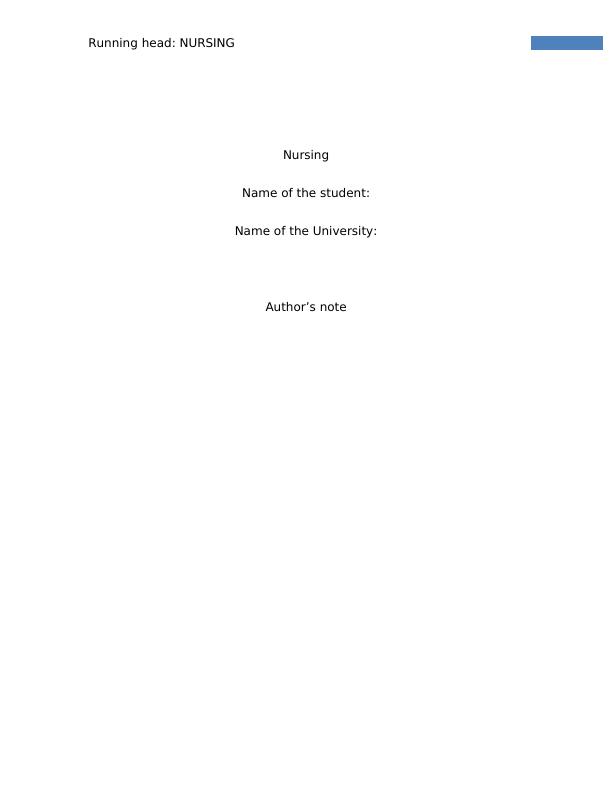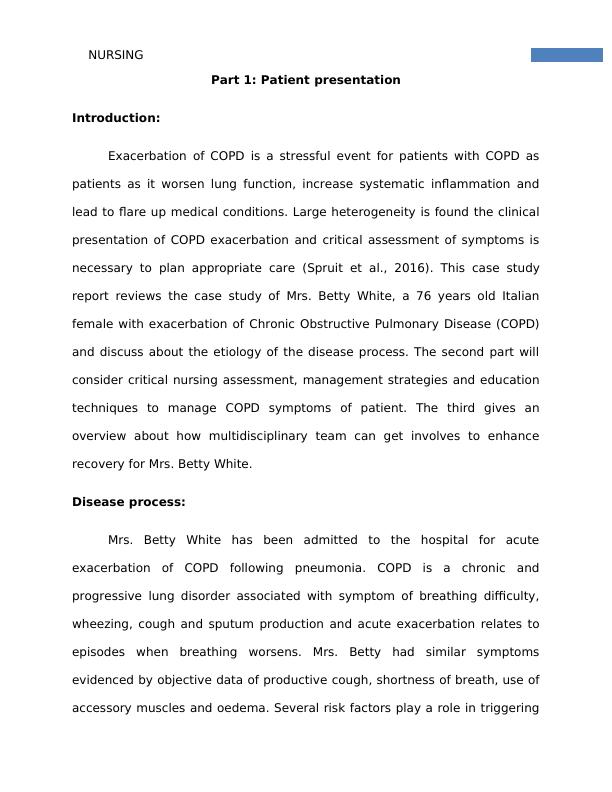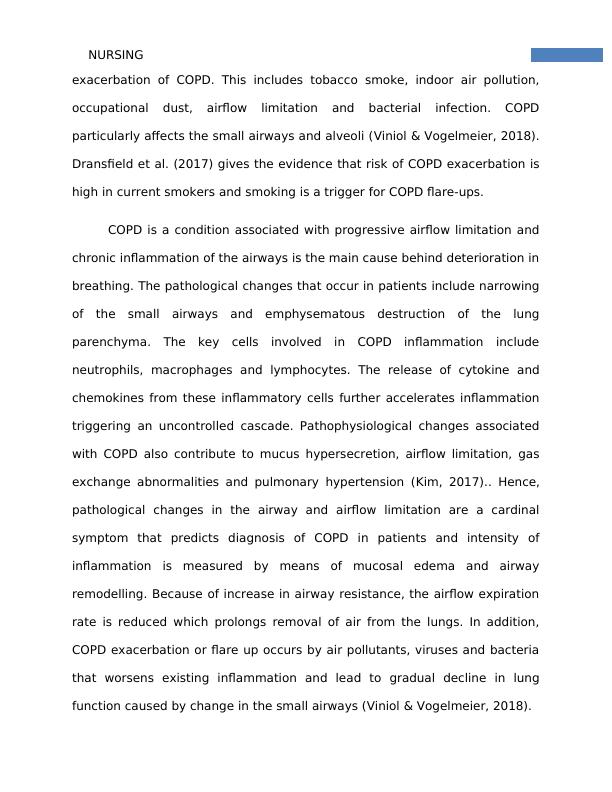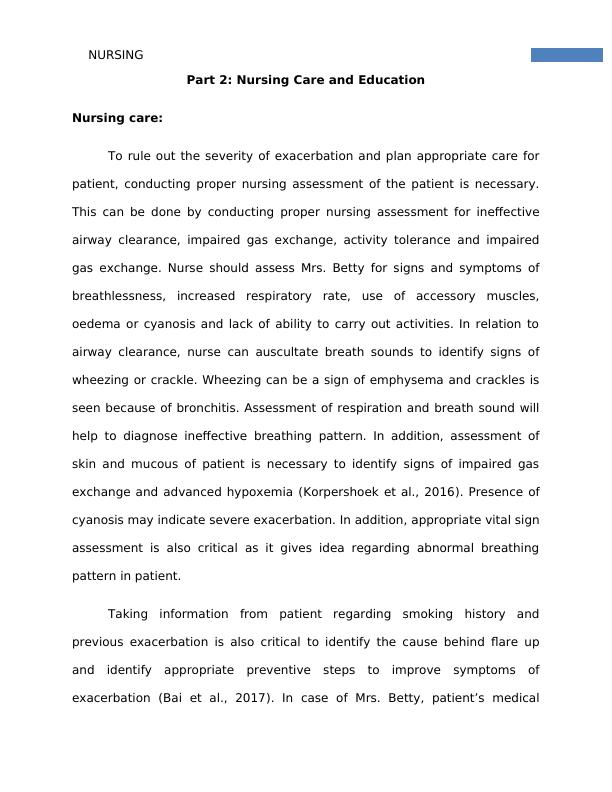Nursing Care and Education for COPD Exacerbation: A Case Study
Added on 2022-10-10
13 Pages2620 Words343 Views
Running head: NURSING
Nursing
Name of the student:
Name of the University:
Author’s note
Nursing
Name of the student:
Name of the University:
Author’s note

NURSING
Part 1: Patient presentation
Introduction:
Exacerbation of COPD is a stressful event for patients with COPD as
patients as it worsen lung function, increase systematic inflammation and
lead to flare up medical conditions. Large heterogeneity is found the clinical
presentation of COPD exacerbation and critical assessment of symptoms is
necessary to plan appropriate care (Spruit et al., 2016). This case study
report reviews the case study of Mrs. Betty White, a 76 years old Italian
female with exacerbation of Chronic Obstructive Pulmonary Disease (COPD)
and discuss about the etiology of the disease process. The second part will
consider critical nursing assessment, management strategies and education
techniques to manage COPD symptoms of patient. The third gives an
overview about how multidisciplinary team can get involves to enhance
recovery for Mrs. Betty White.
Disease process:
Mrs. Betty White has been admitted to the hospital for acute
exacerbation of COPD following pneumonia. COPD is a chronic and
progressive lung disorder associated with symptom of breathing difficulty,
wheezing, cough and sputum production and acute exacerbation relates to
episodes when breathing worsens. Mrs. Betty had similar symptoms
evidenced by objective data of productive cough, shortness of breath, use of
accessory muscles and oedema. Several risk factors play a role in triggering
Part 1: Patient presentation
Introduction:
Exacerbation of COPD is a stressful event for patients with COPD as
patients as it worsen lung function, increase systematic inflammation and
lead to flare up medical conditions. Large heterogeneity is found the clinical
presentation of COPD exacerbation and critical assessment of symptoms is
necessary to plan appropriate care (Spruit et al., 2016). This case study
report reviews the case study of Mrs. Betty White, a 76 years old Italian
female with exacerbation of Chronic Obstructive Pulmonary Disease (COPD)
and discuss about the etiology of the disease process. The second part will
consider critical nursing assessment, management strategies and education
techniques to manage COPD symptoms of patient. The third gives an
overview about how multidisciplinary team can get involves to enhance
recovery for Mrs. Betty White.
Disease process:
Mrs. Betty White has been admitted to the hospital for acute
exacerbation of COPD following pneumonia. COPD is a chronic and
progressive lung disorder associated with symptom of breathing difficulty,
wheezing, cough and sputum production and acute exacerbation relates to
episodes when breathing worsens. Mrs. Betty had similar symptoms
evidenced by objective data of productive cough, shortness of breath, use of
accessory muscles and oedema. Several risk factors play a role in triggering

NURSING
exacerbation of COPD. This includes tobacco smoke, indoor air pollution,
occupational dust, airflow limitation and bacterial infection. COPD
particularly affects the small airways and alveoli (Viniol & Vogelmeier, 2018).
Dransfield et al. (2017) gives the evidence that risk of COPD exacerbation is
high in current smokers and smoking is a trigger for COPD flare-ups.
COPD is a condition associated with progressive airflow limitation and
chronic inflammation of the airways is the main cause behind deterioration in
breathing. The pathological changes that occur in patients include narrowing
of the small airways and emphysematous destruction of the lung
parenchyma. The key cells involved in COPD inflammation include
neutrophils, macrophages and lymphocytes. The release of cytokine and
chemokines from these inflammatory cells further accelerates inflammation
triggering an uncontrolled cascade. Pathophysiological changes associated
with COPD also contribute to mucus hypersecretion, airflow limitation, gas
exchange abnormalities and pulmonary hypertension (Kim, 2017).. Hence,
pathological changes in the airway and airflow limitation are a cardinal
symptom that predicts diagnosis of COPD in patients and intensity of
inflammation is measured by means of mucosal edema and airway
remodelling. Because of increase in airway resistance, the airflow expiration
rate is reduced which prolongs removal of air from the lungs. In addition,
COPD exacerbation or flare up occurs by air pollutants, viruses and bacteria
that worsens existing inflammation and lead to gradual decline in lung
function caused by change in the small airways (Viniol & Vogelmeier, 2018).
exacerbation of COPD. This includes tobacco smoke, indoor air pollution,
occupational dust, airflow limitation and bacterial infection. COPD
particularly affects the small airways and alveoli (Viniol & Vogelmeier, 2018).
Dransfield et al. (2017) gives the evidence that risk of COPD exacerbation is
high in current smokers and smoking is a trigger for COPD flare-ups.
COPD is a condition associated with progressive airflow limitation and
chronic inflammation of the airways is the main cause behind deterioration in
breathing. The pathological changes that occur in patients include narrowing
of the small airways and emphysematous destruction of the lung
parenchyma. The key cells involved in COPD inflammation include
neutrophils, macrophages and lymphocytes. The release of cytokine and
chemokines from these inflammatory cells further accelerates inflammation
triggering an uncontrolled cascade. Pathophysiological changes associated
with COPD also contribute to mucus hypersecretion, airflow limitation, gas
exchange abnormalities and pulmonary hypertension (Kim, 2017).. Hence,
pathological changes in the airway and airflow limitation are a cardinal
symptom that predicts diagnosis of COPD in patients and intensity of
inflammation is measured by means of mucosal edema and airway
remodelling. Because of increase in airway resistance, the airflow expiration
rate is reduced which prolongs removal of air from the lungs. In addition,
COPD exacerbation or flare up occurs by air pollutants, viruses and bacteria
that worsens existing inflammation and lead to gradual decline in lung
function caused by change in the small airways (Viniol & Vogelmeier, 2018).

NURSING
Part 2: Nursing Care and Education
Nursing care:
To rule out the severity of exacerbation and plan appropriate care for
patient, conducting proper nursing assessment of the patient is necessary.
This can be done by conducting proper nursing assessment for ineffective
airway clearance, impaired gas exchange, activity tolerance and impaired
gas exchange. Nurse should assess Mrs. Betty for signs and symptoms of
breathlessness, increased respiratory rate, use of accessory muscles,
oedema or cyanosis and lack of ability to carry out activities. In relation to
airway clearance, nurse can auscultate breath sounds to identify signs of
wheezing or crackle. Wheezing can be a sign of emphysema and crackles is
seen because of bronchitis. Assessment of respiration and breath sound will
help to diagnose ineffective breathing pattern. In addition, assessment of
skin and mucous of patient is necessary to identify signs of impaired gas
exchange and advanced hypoxemia (Korpershoek et al., 2016). Presence of
cyanosis may indicate severe exacerbation. In addition, appropriate vital sign
assessment is also critical as it gives idea regarding abnormal breathing
pattern in patient.
Taking information from patient regarding smoking history and
previous exacerbation is also critical to identify the cause behind flare up
and identify appropriate preventive steps to improve symptoms of
exacerbation (Bai et al., 2017). In case of Mrs. Betty, patient’s medical
Part 2: Nursing Care and Education
Nursing care:
To rule out the severity of exacerbation and plan appropriate care for
patient, conducting proper nursing assessment of the patient is necessary.
This can be done by conducting proper nursing assessment for ineffective
airway clearance, impaired gas exchange, activity tolerance and impaired
gas exchange. Nurse should assess Mrs. Betty for signs and symptoms of
breathlessness, increased respiratory rate, use of accessory muscles,
oedema or cyanosis and lack of ability to carry out activities. In relation to
airway clearance, nurse can auscultate breath sounds to identify signs of
wheezing or crackle. Wheezing can be a sign of emphysema and crackles is
seen because of bronchitis. Assessment of respiration and breath sound will
help to diagnose ineffective breathing pattern. In addition, assessment of
skin and mucous of patient is necessary to identify signs of impaired gas
exchange and advanced hypoxemia (Korpershoek et al., 2016). Presence of
cyanosis may indicate severe exacerbation. In addition, appropriate vital sign
assessment is also critical as it gives idea regarding abnormal breathing
pattern in patient.
Taking information from patient regarding smoking history and
previous exacerbation is also critical to identify the cause behind flare up
and identify appropriate preventive steps to improve symptoms of
exacerbation (Bai et al., 2017). In case of Mrs. Betty, patient’s medical

End of preview
Want to access all the pages? Upload your documents or become a member.
Related Documents
Palliative Care: Strategies for COPD Patientslg...
|7
|1829
|101
Pathophysiology of COPD, Acute Exacerbation, Pneumonia, and Interventions for COPD Managementlg...
|10
|2873
|82
Palliative Care: Strategies for COPD Exacerbation Managementlg...
|6
|1682
|50
Palliative Life Carelg...
|8
|2002
|74
(PDF) Pathophysiology of Chronic Obstructive Pulmonary Disease (COPD)lg...
|16
|3650
|128
Chronic Obstructive Pulmonary Disease (COPD) | Case Study Analysis.lg...
|13
|3687
|17